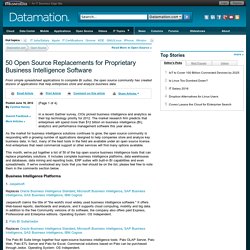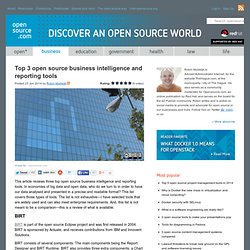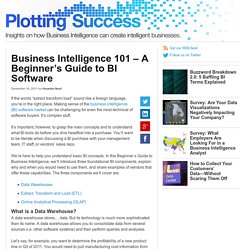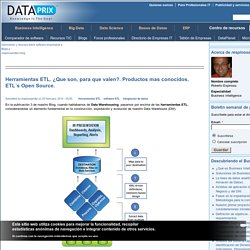

17 Open Source and Free Business Intelligence Solutions. 50 Open Source Replacements for Proprietary Business Intelligence Software. In a recent Gartner survey, CIOs picked business intelligence and analytics as their top technology priority for 2012.

The market research firm predicts that enterprises will spend more than $12 billion on business intelligence (BI), analytics and performance management software this year alone. As the market for business intelligence solutions continues to grow, the open source community is responding with a growing number of applications designed to help companies store and analyze key business data. In fact, many of the best tools in the field are available under an open source license. And enterprises that need commercial support or other services will find many options available. This month, we've put together a list of 50 of the top open source business intelligence tools that can replace proprietary solutions. Business Intelligence Platforms 1. Jaspersoft claims the title of "the world's most widely used business intelligence software. " 2. 3. 4. 5. 10 Open Source ERP Options. Posted November 10, 2014 By Paul RubensFeedback While the ERP market is dominated by software giants like SAP and Oracle, there are plenty of open source ERP options.

Take a look at the ERP market and you'll find a landscape dominated by a handful of commercial products offered by well-known enterprise software vendors such as SAP, Oracle, Microsoft and Sage. Although there are plenty of open source ERP projects, their combined market share is negligible - perhaps as little as 1 or 2 percent. That's despite the many known advantages of open source software, such as the fact that it is usually free to download and can be customized as much as needed. What accounts for this measly market share? That's important because ERP systems are mission-critical applications, and selecting a good one is far from easy. There's also the problem of expertise. Here are some of the best open source ERP offerings available today: Top enterprise-ready, open source business tools. This article reviews three top open source business intelligence and reporting tools.

In economies of big data and open data, who do we turn to in order to have our data analysed and presented in a precise and readable format? This list covers those types of tools. The list is not exhaustive—I have selected tools that are widely used and can also meet enterprise requirements. And, this list is not meant to be a comparison—this is a review of what is available. BIRT is part of the open source Eclipse project and was first released in 2004. BIRT consists of several components. The BIRT Report Designer has a rich feature set, is robust, and performs well. If you are looking for support, you can either check out the BIRT community or the Developer Center at Actuate.
BIRT is licensed under the Eclipse Public License. JasperReport TIBCO recently acquired JasperSoft, the company formerly behind JasperReport. A full feature list of JasperSoft (Studio) can be viewed here. Pentaho. 17 Open Source and Free Business Intelligence Solutions. Business Intelligence 101 - A Beginner's Guide to BI Software. If the words “extract transform load” sound like a foreign language, you’re in the right place.

Making sense of the business intelligence (BI) software market can be challenging for even the most technical of software buyers. It’s complex stuff. It’s important, however, to grasp the main concepts and to understand what BI tools do before you dive headfirst into a purchase. You’ll want to be literate when discussing a BI purchase with your management team, IT staff, or vendors’ sales reps. We’re here to help you understand basic BI concepts. What is a Data Warehouse? A data warehouse stores… data. Let’s say, for example, you want to determine the profitability of a new product line in Q3 of 2011. A data warehouse is organized in a way that is optimized for complex analysis of data from multiple systems, whereas the underlying operational systems are optimized to handle a high volume of transactions specific to their function.
What’s the difference? What is Extract, Transform and Load (ETL)? Herramientas ETL. ¿Que son, para que valen?. Productos mas conocidos. ETL´s Open Source. En la publicación 3 de nuestro Blog, cuando hablabamos de Data Warehousing, pasamos por encima de las herramientas ETL, considerandolas un elemento fundamental en la construcción, explotación y evolución de nuestro Data Warehouse (DW).

Esquema Tipico de Herramienta ETL Decíamos que las herramientas ETL, deberían de proporcionar, de forma general, las siguientes funcionalidades: Es hora de ampliar las definiciones y entrar un poco mas a fondo en lo que son realmente las ETL´s: Definición de ETL Si ampliamos las definiciones, en la Wikipedia se dice lo siguiente de las herramientas ETL: ETL son las siglas en inglés de Extraer, Transformar y Cargar (Extract, Transform and Load). Los procesos ETL también se pueden utilizar para la integración con sistemas heredados (aplicaciones antiguas existentes en las organizaciones que se han de integrar con los nuevos aplicativos, por ejemplo, ERP´s.